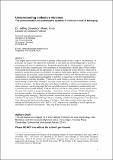Files in this item
Understanding collective violence : the communicative and performative qualities of violence in acts of belonging
Item metadata
| dc.contributor.author | Murer, Jeffrey Stevenson | |
| dc.contributor.editor | Bantekas, Ilias | |
| dc.contributor.editor | Mylonaki, Emmanouela | |
| dc.date.accessioned | 2017-11-06T10:30:07Z | |
| dc.date.available | 2017-11-06T10:30:07Z | |
| dc.date.issued | 2014-11 | |
| dc.identifier | 135620688 | |
| dc.identifier | c862ca62-74ea-49dd-8dc9-2fd55aaefb64 | |
| dc.identifier | 84953807494 | |
| dc.identifier | 000357269700013 | |
| dc.identifier.citation | Murer , J S 2014 , Understanding collective violence : the communicative and performative qualities of violence in acts of belonging . in I Bantekas & E Mylonaki (eds) , Criminological approaches to international criminal law . Cambridge University Press , Cambridge , pp. 287-315 . https://doi.org/10.1017/CBO9781107446700.013 | en |
| dc.identifier.isbn | 9781107060036 | |
| dc.identifier.isbn | 9781107446700 | |
| dc.identifier.other | ORCID: /0000-0002-8056-9365/work/76386579 | |
| dc.identifier.uri | https://hdl.handle.net/10023/11998 | |
| dc.description.abstract | This chapter explores the motivations for joining violent groups across arange of circumstances. In particular, the chapter will explore the similarities in the role of violence as a marker of identity within groups as diverseas street gangs and ethnic communities. Frequently, membership inviolent groups is explained in terms of individual material gain or theattainment of individual fame, in very rationalist and individualistic terms.This focus on individual choice and motivation suggests the use or disinclination to use violence is an expression of individual agency. Indeed, many of studies on civil wars or other armed conflicts treat joining these violent groups and the participation in violent acts as being anti-social, as if the choice to engage in violence is one wholly against social norms or social values. However, much can be gained by seeing these groups in completely the opposite light: gangs, communal factions, militias, even terrorist organisations can be seen as highly social environments. This chapter will examine the performative qualities of violence and the role that violence plays in the experience of belonging in large groups and in collective identity formation. | |
| dc.format.extent | 29 | |
| dc.format.extent | 401610 | |
| dc.language.iso | eng | |
| dc.publisher | Cambridge University Press | |
| dc.relation.ispartof | Criminological approaches to international criminal law | en |
| dc.rights | © Cambridge University Press 2014. This work has been made available online in accordance with the publisher’s policies. This is the author created accepted version manuscript and as such may differ slightly from the final published version. The final published version of this work is available at http://dx.doi.org/10.1017/CBO9781107446700.013 | en |
| dc.subject | HT Communities. Classes. Races | en |
| dc.subject | JX International law | en |
| dc.subject | JZ International relations | en |
| dc.subject | BDC | en |
| dc.subject | R2C | en |
| dc.subject | SDG 16 - Peace, Justice and Strong Institutions | en |
| dc.subject.lcc | HT | en |
| dc.subject.lcc | JX | en |
| dc.subject.lcc | JZ | en |
| dc.title | Understanding collective violence : the communicative and performative qualities of violence in acts of belonging | en |
| dc.type | Book item | en |
| dc.contributor.institution | University of St Andrews.School of International Relations | en |
| dc.contributor.institution | University of St Andrews.The Handa Centre for the Study of Terrorism and Political Violence | en |
| dc.identifier.doi | 10.1017/CBO9781107446700.013 | |
| dc.description.status | Peer reviewed | en |
| dc.identifier.url | https://doi.org/10.1017/CBO9781107446700 | en |
This item appears in the following Collection(s)
Items in the St Andrews Research Repository are protected by copyright, with all rights reserved, unless otherwise indicated.

